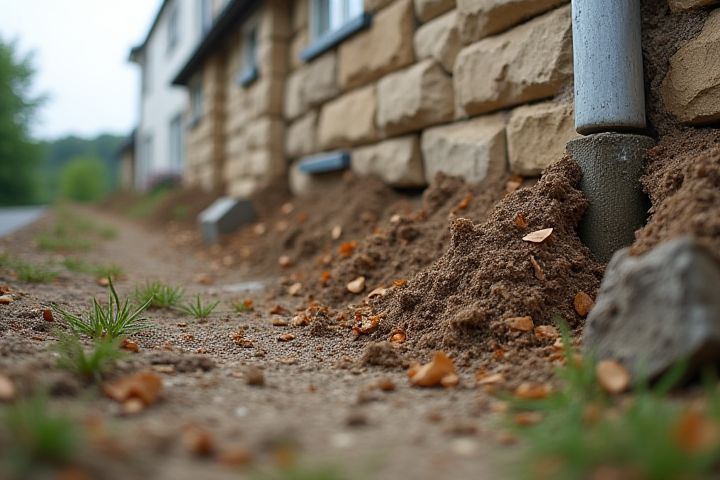
House settling occurs due to a variety of factors, including soil composition, moisture levels, and the weight of the structure itself. As time passes, the soil beneath a home can compress or shrink, often influenced by changes in temperature or moisture content, leading to minor shifts in the foundation. Organic materials in the soil, such as roots or decaying vegetation, can also break down, resulting in voids that contribute to uneven settling. Furthermore, poor drainage or excessive water accumulation near the foundation can erode soil, exacerbating stability issues. Regular inspections and prompt maintenance can help mitigate the effects of settling, ensuring your home remains safe and stable.
What Causes House Settling
Soil composition
House settling is significantly influenced by soil composition, which encompasses the types of soil present and their moisture retention properties. Clay-rich soils tend to expand when wet and shrink when dry, leading to uneven settling as these fluctuations occur. Sandy soils, while generally stable, can lead to rapid drainage and potential sinking if they lack adequate compaction. Understanding your land's soil composition can help predict and mitigate settling issues in your home, ensuring a stable foundation.
Moisture changes
Moisture changes in the soil surrounding your home significantly contribute to house settling. When the soil becomes overly saturated due to heavy rainfall or flooding, it expands, lifting your foundation. Conversely, during dry periods, the soil contracts, leading to potential shifts in your home's alignment. Over time, these cycles of expansion and contraction can result in structural issues, such as cracks in walls or uneven floors, affecting approximately 1 in 5 homes.
Tree root growth
Tree root growth can significantly contribute to house settling as roots expand and exert pressure on soil and foundations. As trees mature, their roots can penetrate beneath the foundation, displacing soil and causing uneven settling. In regions with expansive clay soils, root systems may further exacerbate moisture fluctuations, leading to soil shrinkage and swelling. To mitigate these effects, consider planting trees at least 20 feet away from your home to minimize root interference.
Foundation design
House settling often results from inadequate foundation design, which can lead to uneven weight distribution. A foundation should be designed to accommodate the soil's load-bearing capacity, typically ranging from 1,500 to 2,000 pounds per square foot for conventional residential construction. Poor drainage and inadequate moisture control around the foundation can also destabilize the soil, leading to settling issues. Regular inspections of your property's foundation and surrounding landscape can help identify potential problems before they escalate.
Construction quality
House settling primarily results from the quality of construction, particularly how well the foundation was designed and built. Inadequate soil preparation, such as improper compaction or poor drainage, can lead to uneven settling as moisture levels fluctuate. The materials used, like substandard concrete or inconsistent framing practices, significantly impact a home's ability to withstand weight and stress over time. To minimize settling issues, ensure that your construction team adheres to local building codes and employs best practices throughout the entire building process.
Temperature fluctuations
Temperature fluctuations can significantly impact house settling, primarily due to the expansion and contraction of building materials. Wood, for instance, can swell when temperatures rise and shrink during colder periods, leading to shifts in structural alignment. Concrete and soil also react to temperature changes, with thermal expansion potentially causing foundational stress and minor movements. If your home experiences dramatic temperature swings, you may observe cracks in walls or floors, signaling the need for structural assessment.
Nearby construction
Nearby construction can significantly contribute to house settling due to vibrations and shifts in the soil caused by heavy machinery usage. This disturbance can compromise the integrity of the foundational soil, leading to settling or shifting of your home. The excavation and compaction processes involved in construction can create voids or loosen existing soil, exacerbating the issue. If you are noticing cracks or misalignments in your property after nearby construction, it may be necessary to consult a structural engineer to assess potential impacts on your foundation.
Plumbing leaks
Plumbing leaks are one of the significant causes of house settling, which can lead to structural damage over time. As water seeps into the foundation, it can erode soil, creating voids that compromise stability. Research indicates that homes with active plumbing leaks experience up to a 20% increase in settling rates compared to those without leaks. You should regularly inspect your plumbing system for leaks, as early detection can prevent extensive and costly repairs associated with foundation issues.
Seismic activity
Seismic activity, including earthquakes and tremors, can significantly contribute to house settling, which is the gradual sinking or shifting of a building's foundation. When seismic waves travel through the Earth's crust, they can cause soil liquefaction, leading to increased stress on building foundations, potentially resulting in uneven settling. This phenomenon is particularly prevalent in areas situated near fault lines or those with loose, saturated soil. Your home's structural integrity may be compromised if regular seismic monitoring and appropriate foundation reinforcement measures are not undertaken.
Natural land shifts
House settling is primarily influenced by natural land shifts, including soil compaction, erosion, and seismic activity. For instance, clay soils can expand when wet and contract when dry, causing significant foundational movement over time. In areas prone to earthquakes, ground shaking may lead to sudden changes in soil stability, resulting in immediate structural impacts. Understanding these natural factors is crucial for homeowners to anticipate and address potential settling issues effectively.
